
So here we are–the final figure in the Tennessee Aquarium series from Safari, the only figure released after 1995 (1997 to be exact). This is the common mudpuppy Necturus maculosus, number 210672, probably the hardest to find one and, when stacked together, the largest and most imposing by a wide margin. But, like the yonahlosee salamander, this figure would also have a much longer presence in the Safari catalogue, first as a Translucent figure (green, I think), and then later, as part of the Glow-in-the-Dark series. It wouldn’t be until just a couple years ago that Safari would revisit the mudpuppy with a new sculpt…a much smaller figure in the Great Lakes toob (great set by the way); and wouldn’t revisit a large caudate amphibian figure (read: salamander) again until just this year with their new axolotl (which I don’t think has hit the blog yet…)

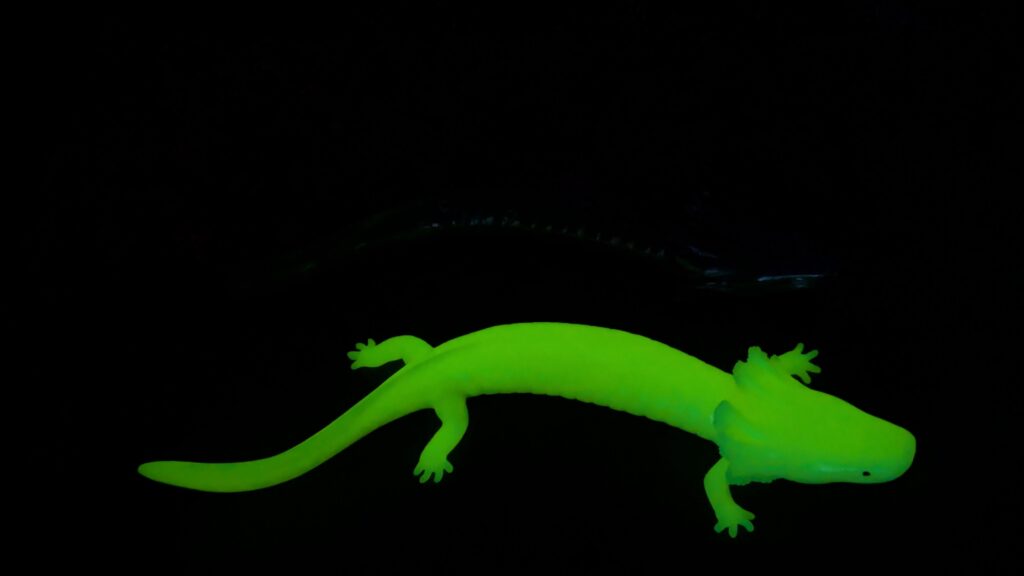
The common mudpuppy is one of five to seven species of Necturus in North America, and together with the olm of the Balkan region of Europe, make up the extant members of the family Proteidae (they have a lot of family members in the fossil record though). In general, they are kind of weird looking animals–they never lose their gills, which facilitates respiration since their lungs are not functional enough for this; they have no eyelids; and tend to have long, serpentine bodies adapted to their aquatic lifestyle; unlike all of the previous salamanders from the set, this common mudpuppy is the only one that does not have a terrestrial phase. As a family, these are also relatively to truly large salamanders; the common mudpuppy has been found over 40 cm (17 inches) long.

Common mudpuppies are found in much of the northeastern part of the United States as well as southern Canada in areas around the Great Lakes, St Lawrence River and connected waterways, south to Georgia–the largest distribution of any of the American salamander species in the set. There’s even an introduced population in Maine! They inhabit ponds, streams and lakes and the oxygenation of their environment can affect the size of the gills–streams and creeks mudpuppies with smaller gills, while more stagnant ponds see much larger gill filaments. They can even survive in waters with frozen surfaces (which is good, since they extend to Canada…)

Common mudpuppies are generally nocturnal, hiding under stones and sunken wood during the day; if the water has poor visibility, they may be more active in the day, so nocturnal behaviour is probably more for predator avoidance (mostly snakes, turtles, fish and crayfish). When hunting they use their wide, flat legs to crawl around the substrate while searching for prey which appears to include any animal they can catch and eat with their fairly robust jaws. They are generally solitary, but females do stay with the fertilized eggs until hatching. The IUCN lists them as Least Concern, but there can be local threats from pollution and habitat disruption (don’t lift or stack stones in creeks where big salamanders might be hiding…or anything. Just don’t.) And of course, they sometimes get caught by people fishing…but are usually thrown back.

So how is the figure? Well, as I mentioned, it’s BIG. Suitably so, as the figures are all to scale, and the common mudpuppy is especially large. The figure is about 33.1 cm long (over a foot long) which puts it at 1:1 scale for a fairly large individual. The material is also noticeably softer, and seemingly more flexible; this could be because the figure is overall longer and has more give, but it does seem to be able to bend a little more easily than the 1995 figures. The overall sculpt of the body is long and smooth, with a slight ridge over the backbone that extends into a broad continuous tail fin. The only other texture on the body is along the sides, where the costal grooves are incised.
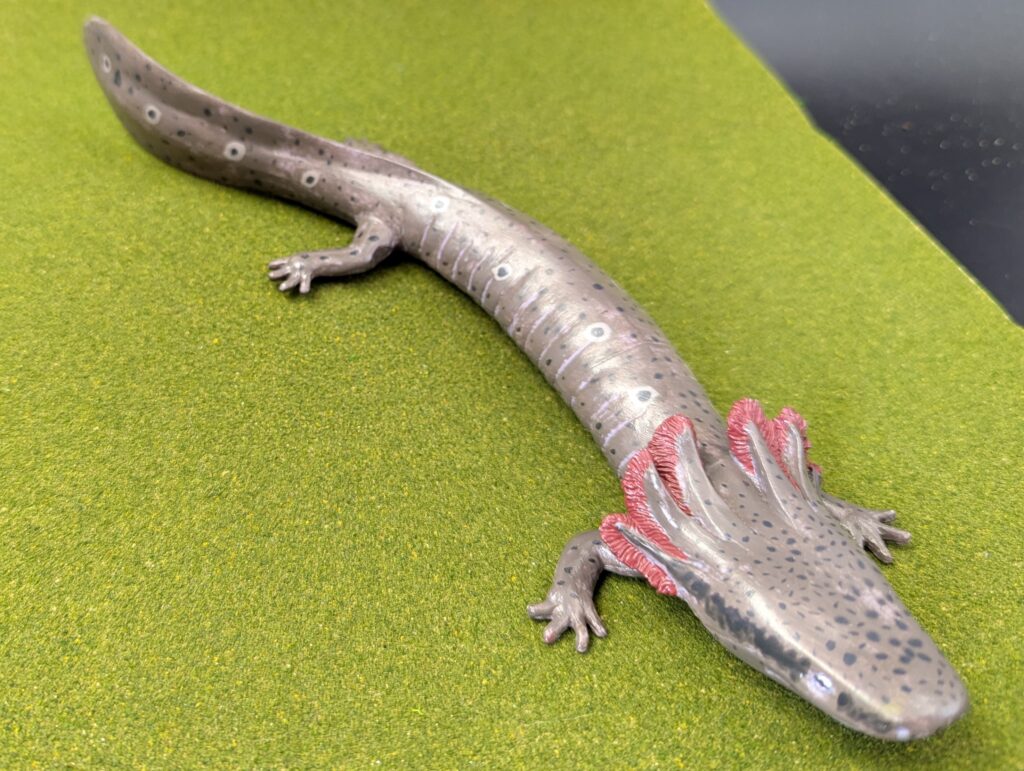

The head is sculpted broad and flat, slightly more narrow at the slightly squared snout. The mouth is closed and deeply sculpted, with the lower jaw subtly underslung. A nostril is present as a small divot just behind the tip of the snout, and the eyes are present near the top of the head about midway along the line of the mouth. The eyes stand out brightly, painted a solid white with a horizontal black pupil–it gives a striking, alert appearance to the animal. At the back of the head is the most characteristic feature of a mudpuppy–the extended gill filaments that extend far back beyond the head. There are three thick processes extending out, coloured like the rest of the body, and around each one is a fringe of red, feathered gill filaments; these are sculpted as a single, continuous border, incised to have the feathery look. There is some overlap among the gills which is probably for production purposes; in the real animals the filaments are often more separate. The filaments are painted dark red, reflecting the high amount of circulatory vessels in these structures that aid in respiration.
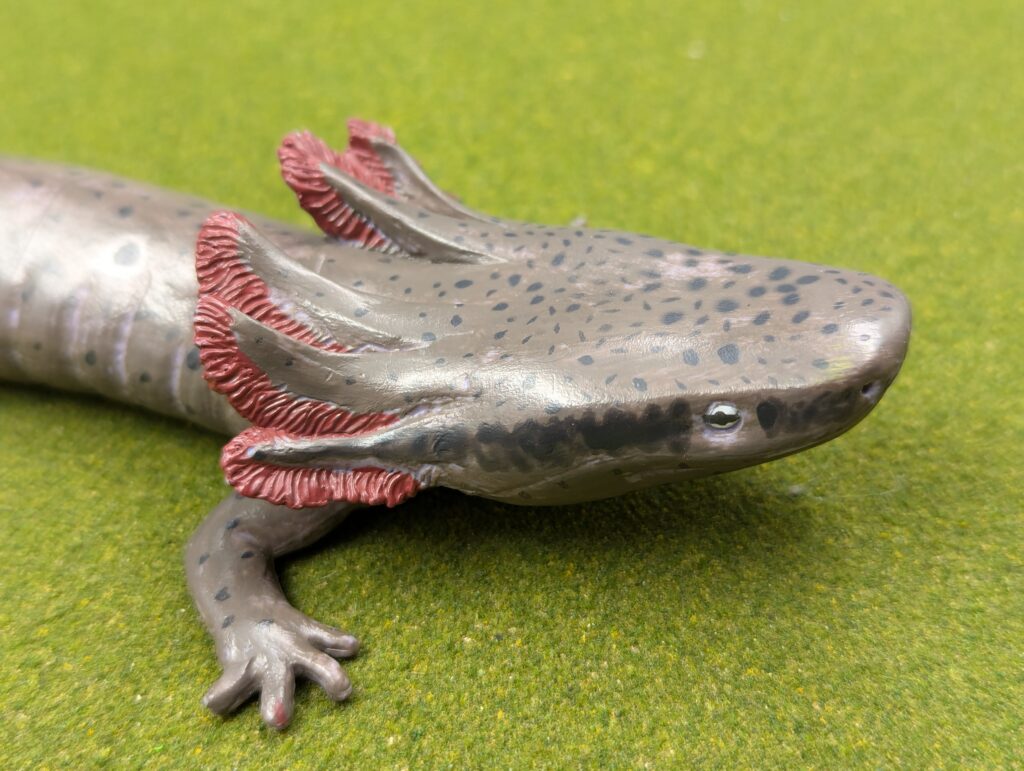
Behind the head, the body is curved slightly to the right, and the grooves are sculpted so that they are wider on the left, and more compressed on the right–a subtle but well thought out sculpt. Just past the hips, the tail quickly compresses laterally, about a quarter the total length of the figure, and has a slight curve leftward. There is a cloacal bulge sculpted posterior to the hind legs…this seems strange, this feature is usually present anterior to or in line with the pelvis, but is physiologically correct for mudpuppies. Between the arms is a small depression, probably reflecting a flexing of the arms. At the joint between the head and body is a sculpted groove, with the jaw a little wider. The rest of the belly is smooth. The arms and legs are sculpted splayed out, possibly in a ‘crawling along the bottom’ action. All of the limbs are quite flattened, and the joints are pretty smooth. The hands and feet are quite squared and as is correct, have four long, thick toes.
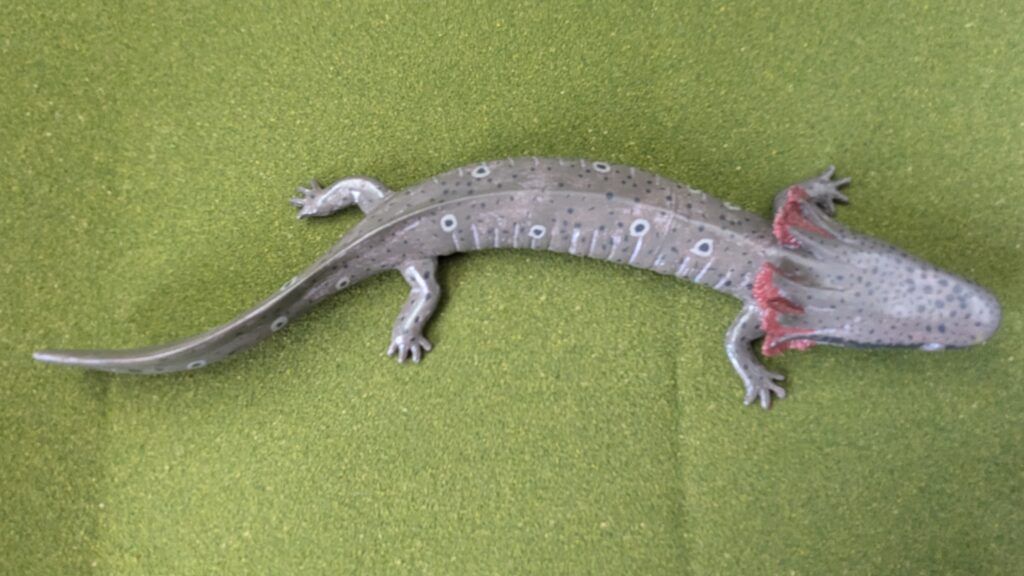
The colours on the figure are very reflective of a living mudpuppy, although they are so variable and complex, I suppose there was a lot of freedom as long as the colours were close! The base colour of the body, most likely of the actual plastic material itself, is a darkish violet colour, although it is sporadically lighter in some blotches as well. The head, body, tail and legs are all covered in irregular black spots, heaviest on the head and more sporadic on the tail. Along the sides of the body, in line with the tops of the costal grooves, and along the tail along the top of the tail, are distinct bullseye spots, a large dark-purple spot ringed by an irregular light pinkish-grey border. There are four on each side of the body, four on the right side of the tail and three on the left side. The patterns and spots certainly in line with the possible colours for mudpuppies, although they may tend to more brownish–the way it is painted appears to reflect an animal either underwater, or at least adapted to a more murky environment. All in all, a good reflection of these big salamanders.
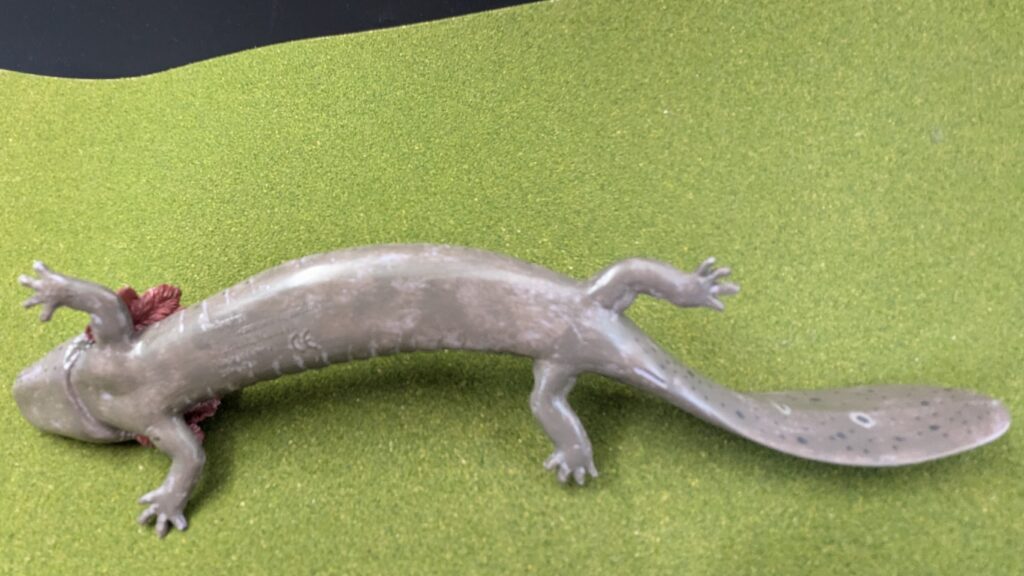
So that ends the journey with what is probably one of Safari’s most storied and sought-after series (second, maybe, to the Baltimore Aquarium dart frogs…). It is an excellent collection of some great models of salamanders that we have yet to see again; other companies have made a figure or two, but not like this. More, we rarely see these types of salamanders made at this scale (lots of fire salamanders, admittedly…) When people refer to museum-quality figures, this is the type of model that was being referred to and I’m proud to be able to have the whole lot on my shelves. I also understand why collectors of wildlife figures search for these so hard–and why they command the prices that they do. But…we’re not quite finished with out-of-production scale-model Safari salamanders from Tennessee just yet…as a wise puppet once said, “there is another”. I’ll get to it in the future!

Disclaimer: links to Ebay and Amazon on the AnimalToyBlog are affiliate links, so we make a small commission if you use them. Thanks for supporting us!



